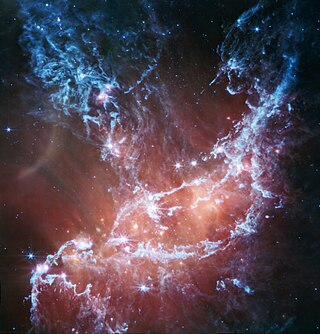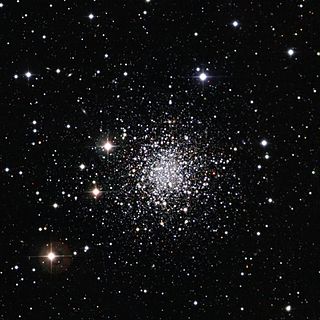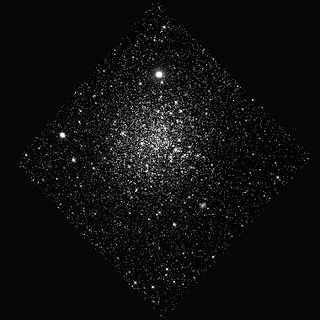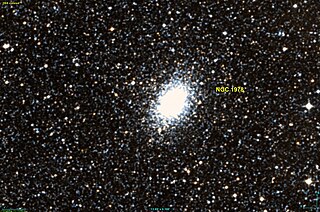
NGC 1427 is a low-luminosity elliptical galaxy located approximately 71 million light-years away from Earth. It was discovered by John Frederick William Herschel on November 28, 1837. It is a member of the Fornax Cluster. The galaxy has a stellar mass of 7.9 × 1010M☉, and a total mass of 9.4 × 1010M☉. However, the mass of the dark matter halo surrounding the galaxy is around 4.3 × 1012M☉.

NGC 346 is a young open cluster of stars with associated nebula located in the Small Magellanic Cloud (SMC) that appears in the southern constellation of Tucana. It was discovered August 1, 1826 by Scottish astronomer James Dunlop. J. L. E. Dreyer described it as, "bright, large, very irregular figure, much brighter middle similar to double star, mottled but not resolved". On the outskirts of the cluster is the multiple star system HD 5980, one of the brightest stars in the SMC.

R136a1 is one of the most massive and luminous stars known, at nearly 200 M☉ and nearly 4.7 million L☉, and is also one of the hottest, at around 46,000 K. It is a Wolf–Rayet star at the center of R136, the central concentration of stars of the large NGC 2070 open cluster in the Tarantula Nebula in the Large Magellanic Cloud. The cluster can be seen in the far southern celestial hemisphere with binoculars or a small telescope, at magnitude 7.25. R136a1 itself is 100 times fainter than the cluster and can only be resolved using speckle interferometry.

NGC 1806 is a globular cluster located within the Large Magellanic Cloud within the constellation of Dorado, an area of the sky best seen from the Earth's southern hemisphere. It was discovered in 1836 by the British astronomer John Herschel. At an aperture of 50 arcseconds, its apparent V-band magnitude is 11.00, but at this wavelength, it has 0.05 magnitudes of interstellar extinction.

NGC 2257 is a globular cluster that lies on the outskirts of the Large Magellanic Cloud (LMC). It was discovered in 1834 by John Herschel. The compiler of the New General Catalogue, John Louis Emil Dreyer, described this cluster as "faint, considerably large, round, very gradually a little brighter middle, mottled but not resolved, 17.0 seconds of time diameter." At an aperture of 30.5 arcseconds, its apparent V-band magnitude is 12.62, but at this wavelength, it has 0.12 magnitudes of interstellar extinction.

R136a2 is a Wolf-Rayet star residing near the center of the R136, the central concentration of stars of the large NGC 2070 open cluster in the Tarantula Nebula, a massive H II region in the Large Magellanic Cloud which is a nearby satellite galaxy of the Milky Way. It has one of the highest confirmed masses and luminosities of any known star, at about 151 M☉ and 3.5 million L☉ respectively.
BAT99-98 is a Wolf–Rayet star located in the Large Magellanic Cloud, in NGC 2070 near the R136 cluster in the Tarantula Nebula. At 226 M☉ and 5,000,000 L☉ it is one of the most massive and luminous stars currently known.

NGC 339 is a globular cluster in the constellation Tucana the Toucan. It is located both visually and physically in the Small Magellanic Cloud, being only about 10,000 ± 12,000 light years closer than the cloud. It is rather prominent, being the brightest cluster in the southern reaches of the cloud. It was discovered by John Herschel on September 18, 1835. It was observed in 2005 by the Hubble Space Telescope. Its apparent V-band magnitude is 12.12, but at this wavelength, it has 0.19 magnitudes of interstellar extinction.

NGC 121 is a globular cluster of stars in the southern constellation of Tucana. It is the oldest globular cluster in the Small Magellanic Cloud (SMC), which is a dwarf satellite galaxy of the Milky Way. This cluster was first discovered by English astronomer John Herschel on September 20, 1835. The compiler of the New General Catalogue, Danish astronomer John Louis Emil Dreyer, described this object as "pretty bright, pretty small, little extended, very gradually brighter middle". The cluster is located at a distance of around 200,000 light-years (60 kpc) from the Sun.

AB8, also known as SMC WR8, is a binary star in the Small Magellanic Cloud (SMC). A Wolf-Rayet star and a main sequence companion of spectral type O orbit in a period of 16.638 days. It is one of only nine known WO stars, the only Wolf-Rayet star in the SMC not on the nitrogen sequence, and the only Wolf-Rayet star in the SMC outside the main bar.

NGC 152 is an open cluster in the constellation Tucana. It was discovered by John Herschel on September 20, 1835. It is located within the Small Magellanic Cloud.

NGC 330 is an open cluster in the Small Magellanic Cloud. It is located in the constellation Tucana. It was discovered on 1 August 1826 by James Dunlop. It was described by Dreyer as "a globular cluster, very bright, small, a little extended, stars from 13th to 15th magnitude." At an aperture of 31.0 arcseconds, the apparent V-band magnitude is 9.60, but at this wavelength, it also has 0.36 magnitudes of interstellar extinction.

NGC 361 is an open cluster in the Small Magellanic Cloud. It is located in the constellation Tucana. It was discovered on September 6, 1826, by James Dunlop. It was described by Dreyer as "very very faint, pretty large, very little extended, very gradually brighter middle." At an aperture of 31.0 arcseconds, its apparent V-band magnitude is 12.24, but at this wavelength, it has 0.40 magnitudes of interstellar extinction.

NGC 1466 is the New General Catalogue designation for a globular cluster in the deep southern constellation of Hydrus. It is located in the outskirts of the Large Magellanic Cloud, which is a satellite galaxy of the Milky Way. The object was discovered November 26, 1834 by English astronomer John Herschel. John Dreyer described it as "pF, pS, iR, glbM, *7 f", meaning "pretty faint, pretty small, irregular round, gradually a little brighter middle, with a 7th magnitude star nearby". When using a small telescope, this is a "faint, small, unresolved and difficult" target with an angular size of 1.9 arc minutes. It has an integrated visual magnitude of 11.4.

NGC 1846 is a globular cluster containing hundreds of thousands of stars in the outer halo of the Large Magellanic Cloud. It was discovered on November 6, 1826, by James Dunlop and is included in the New General Catalogue. At an aperture of 50 arcseconds, its apparent V-band magnitude is 10.68, but at this wavelength, it has 0.07 magnitudes of interstellar extinction.

NGC 411 is a globular cluster located approximately 55,000 pc (180,000 ly) from Earth in the constellation Tucana. It was discovered in 1826 by James Dunlop. It was described by Dreyer as "extremely faint, pretty large, round, gradually very little brighter middle". At a distance of about 180,000 light years (55,000 parsecs), it is located within the Small Magellanic Cloud. It has a mass of about 3.0×104 M☉, and a luminosity of about 8.0×104 L☉.

NGC 416 is a globular cluster located in the constellation Tucana. It was discovered on September 5, 1826, by James Dunlop. It was described by Dreyer as "faint, pretty small, round, gradually brighter middle". At a distance of about 199,000 ± 9,800 ly (61,000 ± 3,000 pc), it is located within the Small Magellanic Cloud. At an aperture of 31 arcseconds, its apparent V-band magnitude is 11.42, but at this wavelength, it has 0.25 magnitudes of interstellar extinction.

NGC 419 is a globular cluster located approximately 57,000 pc (190,000 ly) from Earth in the constellation Tucana. It was discovered on September 2, 1826, by James Dunlop. It was described by Dreyer as "pretty large, pretty bright, round, gradually brighter middle". At a distance of about 186,000 light years, it is located within the Small Magellanic Cloud. At an aperture of 50 arcseconds, its apparent V-band magnitude is 10.30, but at this wavelength, it has 0.15 magnitudes of interstellar extinction.

NGC 458 is an open cluster located in the constellation Tucana. It was discovered on September 6, 1826, by James Dunlop. It was also observed by John Herschel and DeLisle Stewart. It was described by Dreyer as "pretty faint, large, round, very gradually brighter middle". It was also noted in the second Index Catalogue that it was "probably a cluster, extremely small, close, no nebulosity seen by D.S. ." At an aperture of 31 arcseconds, its apparent V-band magnitude is 11.73, but at this wavelength, it has 0.12 magnitudes of interstellar extinction.

NGC 1978 is an elliptical shaped globular cluster or open cluster in the constellation Dorado. It is located within the Large Magellanic Cloud. It was discovered by James Dunlop on November 6, 1826. At an aperture of 50 arcseconds, its apparent V-band magnitude is 10.20, but at this wavelength, it has 0.16 magnitudes of interstellar extinction. It appears 3.9 arcminutes wide. NGC 1978 has a radial velocity of 293.1 ± 0.9 km/s.


















